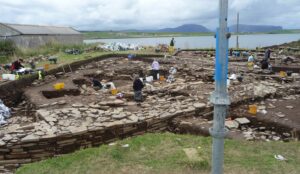
The Guardian recently published a brilliant piece about new legislation in India which has banned the sale of alcohol within 500 metres of state and national highways (Safi 2017). The response to this has been the construction of various mazes so that prospective customers entering the grounds of the bar are required to walk the 500 metres before reaching their goal.
Have a look at the photo in the paper. The result, as you will see, is a layout that bears a remarkable resemblance to the layout of some of the well-known Neolithic buildings in Orkney such as Structure 8 at Barnhouse and Structure 10 at Ness of Brodgar. Both of these buildings have been planned so that they exercise careful control over the movement of those who entered, forcing them to travel further in their quest for the centre. I’m not suggesting that Neolithic Orkney was subject to the same stringent legislation over alcohol as twenty-first century India, but I do think that the Indian example provides a fantastic reminder that, where human behaviour is concerned, all is not always as it might seem.
As archaeologists, we tend to assume that the fancy layout, size, and level of control that these Neolithic structures illustrate all point towards the fact that they were high status buildings, perhaps even buildings that were not open to the common populace. India provides an excellent example where that interpretation would go horribly wrong.
It is always easier to identify and describe structure than it is to explain or interpret it. The problem is that we do, occasionally, confuse the two. We are often in danger of falling in to the trap that the visual complexity of something equates to complexity of purpose. Thus, we can see (we think), that the complex design of these buildings was designed to control the movement of people within them. But we need to be careful of assuming that that control fulfills the requirements of a complex society. It might, indeed, do so; but then again, it might not. We need more information.
Where interpretation (whether of buildings or artefacts) is concerned I always encourage people to read as widely as possible. Only by looking as far afield as you can, at as many contrasting situations as you can find, in as many different places, environments and times as possible, can you open your mind to the myriad of alternatives that our ancestors might have exercised. You have, of course, also to take into account context and related material culture. Nevertheless, this is a timely reminder never to rely on one or two apparent parallels that seem to bolster accepted wisdom, or the theories we happen to like. It is also a reminder that more complex architecture and layouts do not always equate to higher status, or even, dare I say it, higher purpose.
Sometimes, it seems, fancy architecture can, actually, be quite mundane in reality.
You must be logged in to post a comment.